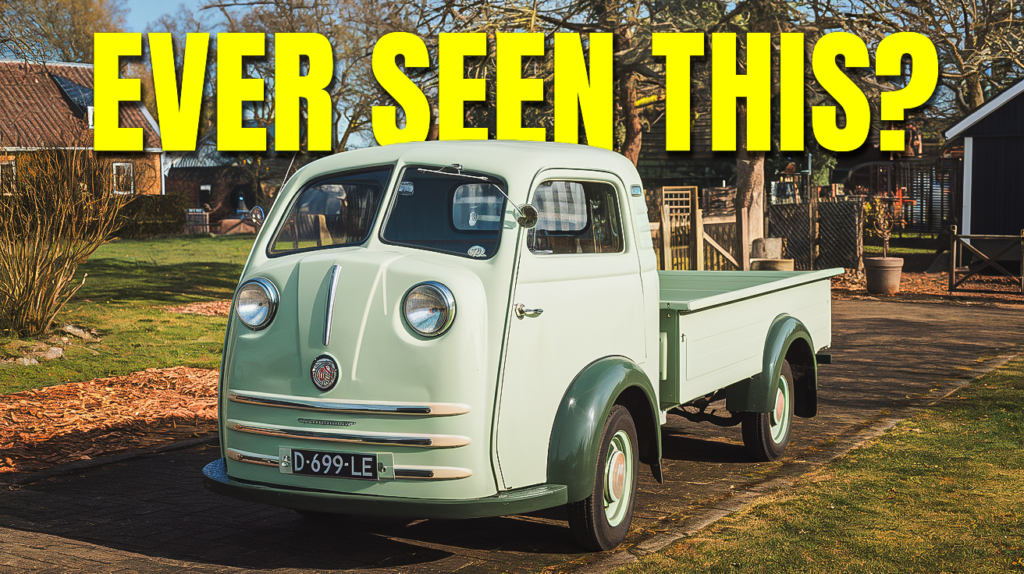
Most truck collections lack true rarities worth showing. The vehicles that impress experts remain hidden from public view, owned by collectors who understand true automotive history. Hidden within abandoned barns and small-town garages sit forgotten treasures worth more than new luxury vehicles. The rarest trucks combine unusual design choices with production numbers so low that most enthusiasts never see one.
Prepare to discover what makes these automotive unicorns special.
18. Ford Durango (1979-1982)
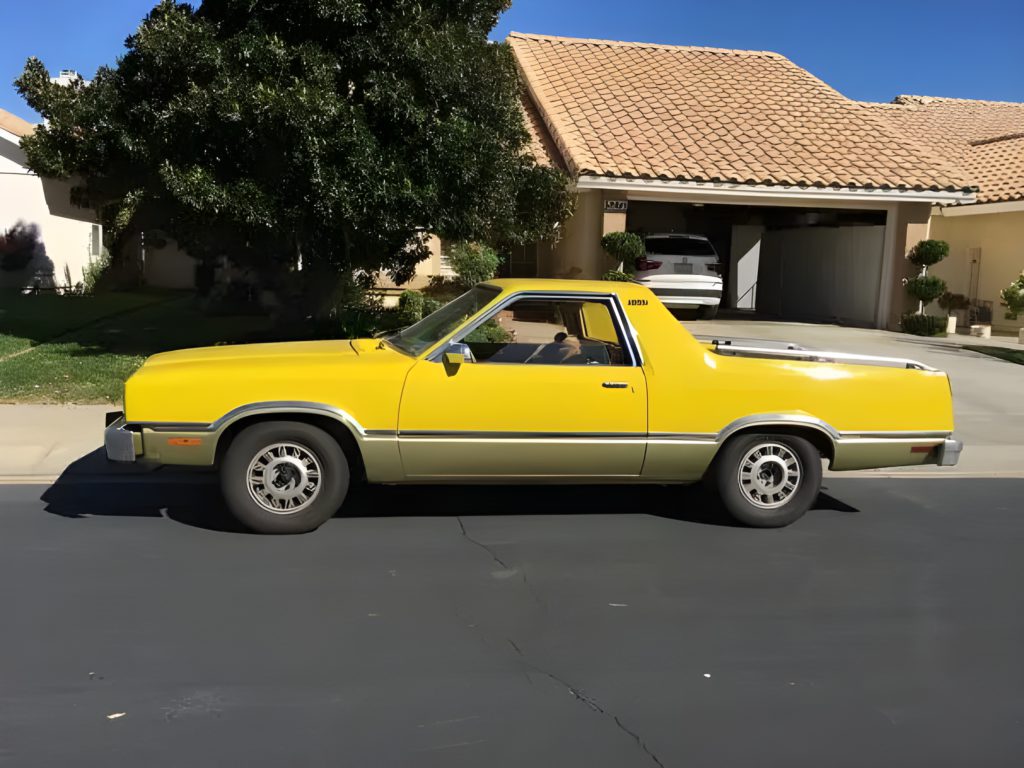
When Ford challenged Chevy’s El Camino, they partnered with National Coach Works to transform the Fairmont Futura into a car-pickup hybrid. Production reached just 200-350 units between 1979-1982, making it one of Ford’s rarest vehicles ever. The Durango maintained the Fairmont’s distinctive front while adding a functional truck bed. Shifting market preferences killed this model before most buyers knew it existed. This “pickup car” category represents Ford’s most obscure production experiment, creating a unicorn that even devoted Ford enthusiasts rarely encounter.
Ford Durango (Interior)
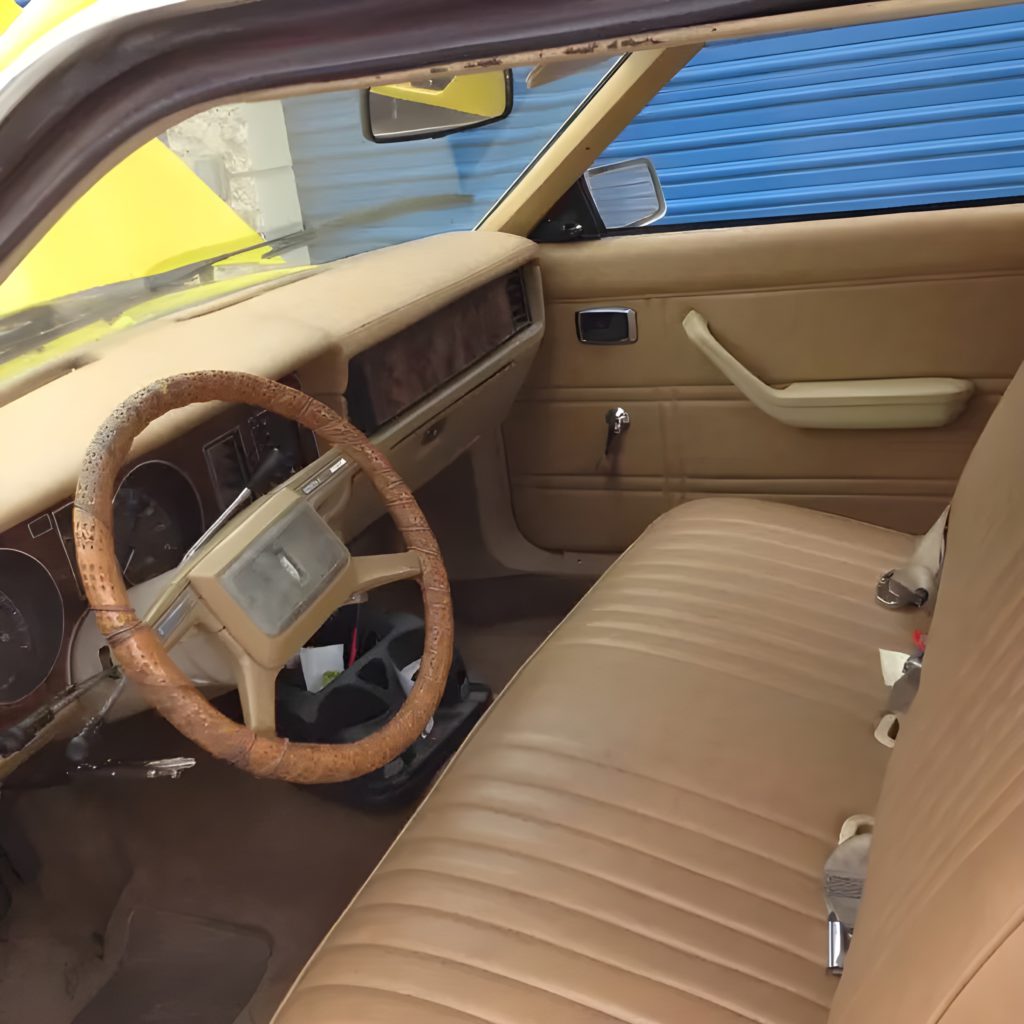
Borrowing directly from the Fairmont Futura, the Durango‘s cabin offered car-like comfort unusual for trucks of that era. The standard 200 cubic-inch inline-six engine delivered adequate power for light-duty use. Bench seating accommodated three passengers with straightforward instrumentation focused on functionality. Despite commercial failure, this vehicle represents an important chapter in car-based pickup evolution. Finding one today requires extraordinary dedication as their tiny production numbers have been further reduced by decades of attrition.
17. Powell Pickup Truck (1955-1957)
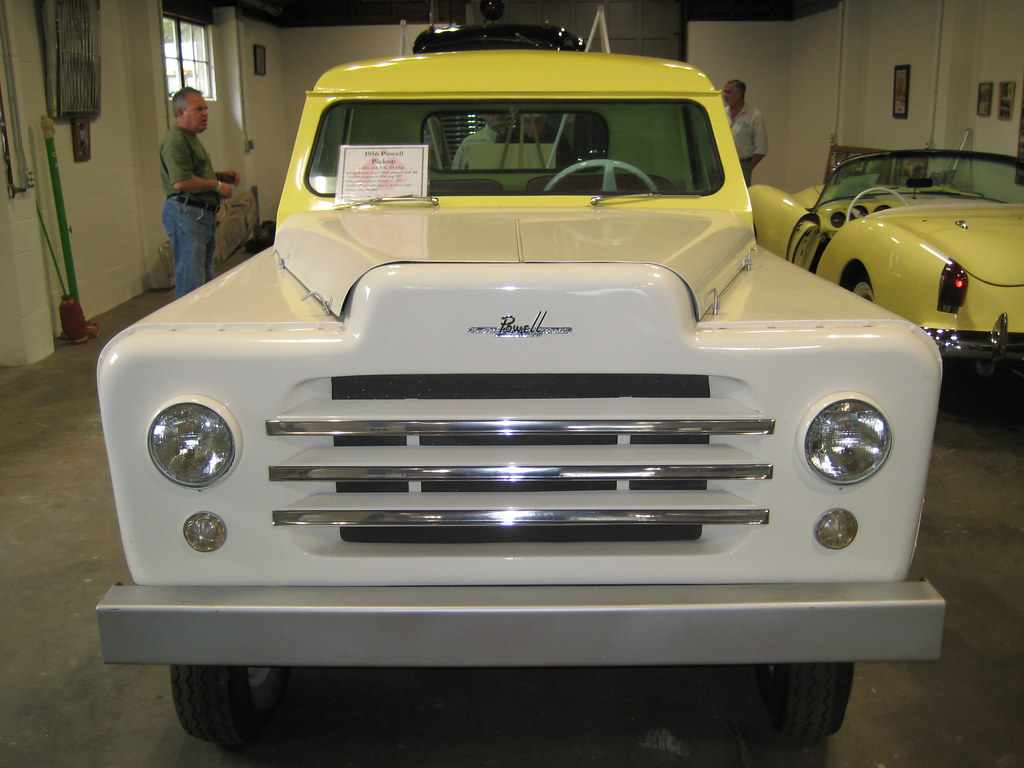
American automotive ingenuity shines in the Powell pickup (1955-1957), built on refurbished Plymouth sedan chassis. These “homemade pickups” featured steel bodies with fiberglass front ends and a unique fishing pole storage tube distinguishing them from conventional trucks. Powell Manufacturing produced approximately 1,000-1,200 units before bankruptcy ended operations. Varied components reflected its unconventional construction, with repurposed chrome from 1950 Ford sedans adorning many examples. This resourceful manufacturing approach created truly unique vehicles rarely seen even in specialized truck collections.
Powell Pickup (Interior)
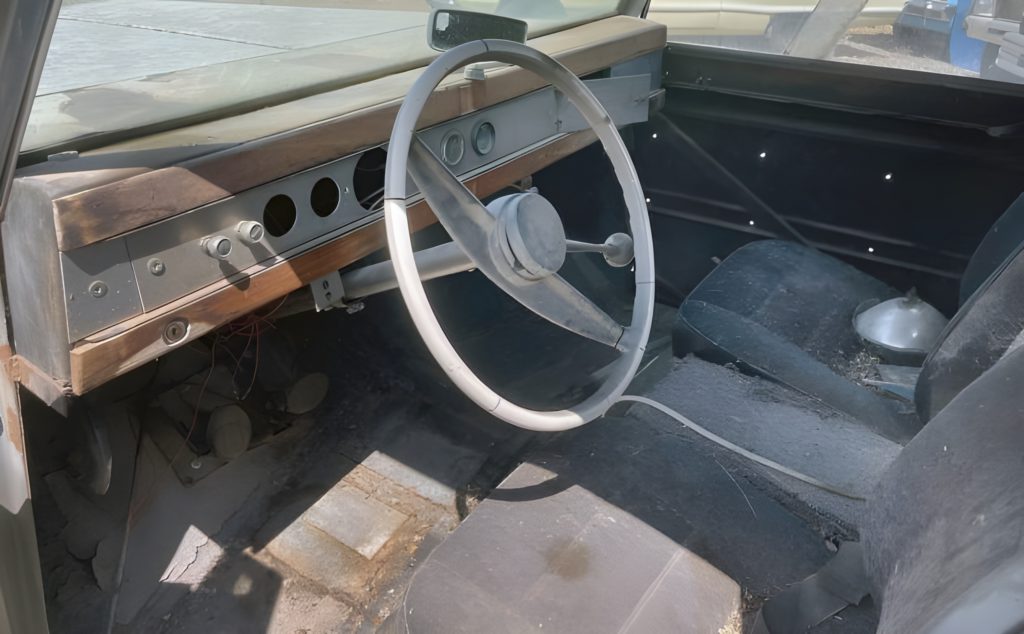
Reflecting its DIY heritage, the Powell’s cabin featured straightforward controls and minimal amenities. The instrument panel provided essential information without unnecessary complexity. Utilitarian materials chosen for durability rather than comfort accommodated driver and passenger. The Powell’s most innovative aspect wasn’t inside the cabin but in its business model – creating new vehicles from existing chassis when competitors required completely new engineering. This approach kept costs manageable but proved unsustainable against larger manufacturers with standardized production methods.
16. Plymouth PT57 (1938)
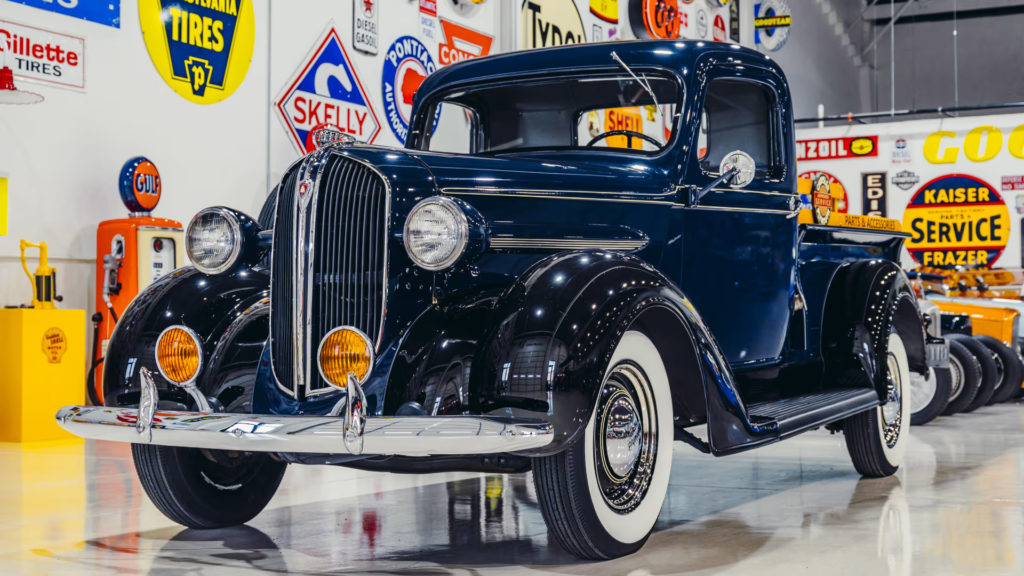
Automotive recovery during the Great Depression took form in the 1938 Plymouth PT57. Rounded fenders and a bold grille established visual presence without excessive ornamentation. The all-steel body provided durability uncommon among lower-priced trucks, while offering multiple color options for personalization. Depression-era design balanced practicality with sufficient style to attract buyers in challenging economic times. Though production figures remain limited, the PT57’s historical significance makes surviving examples highly sought after by serious vintage truck collectors.
Plymouth PT57 (Interior)
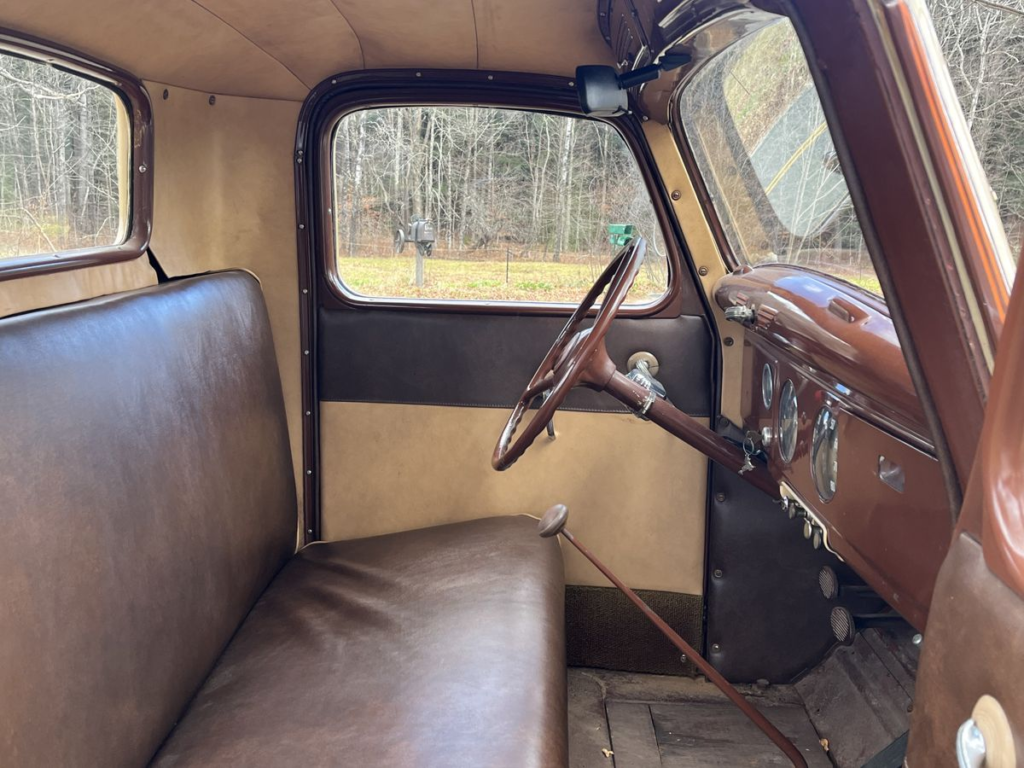
Plymouth prioritized functionality inside the PT57 with logically positioned controls and clear instrumentation. The 201 cubic-inch inline-six engine delivered reliable performance without overwhelming the chassis. Practical interior elements reflected Depression-era priorities – focusing on durability rather than luxury appointments. This approach helped Plymouth weather economic challenges while building a reputation for honest trucks delivering genuine value. Modern collectors prize these pickups both for historical significance and increasingly uncommon pre-war design elements.
15. Studebaker L5 Coupe Express (1939)
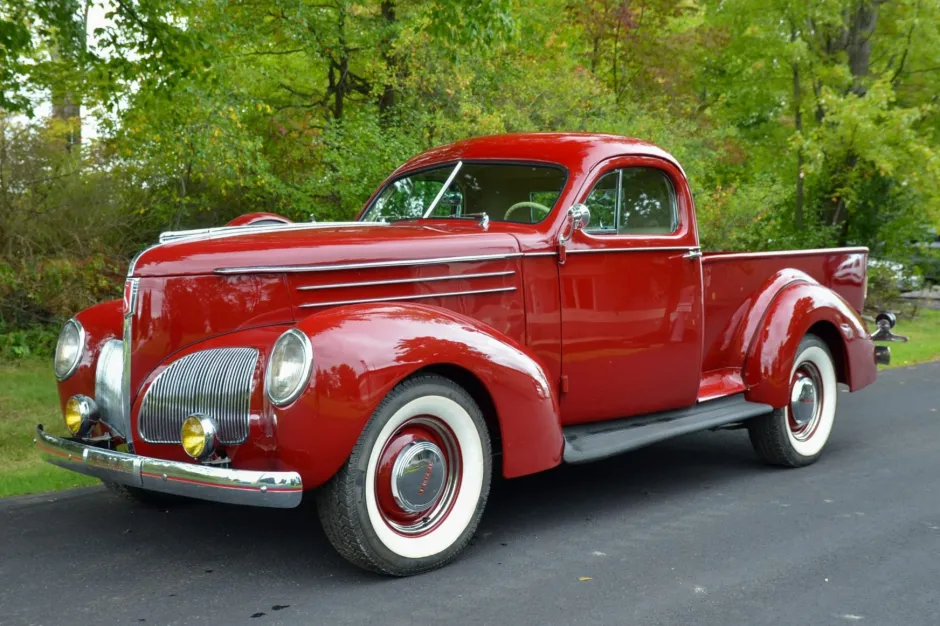
Breaking new ground, the 1939 Studebaker L5 Coupe Express bridged passenger car refinement with truck utility. Improved styling featured a Ford-inspired grille enhancing visual appeal without compromising functionality. The car-truck hybrid design created a distinctive silhouette immediately recognizable as something special. High prices during challenging economic conditions limited sales, creating genuine rarity even among Studebaker’s already uncommon production models. This approach to truck design anticipated modern lifestyle pickups by decades.
Studebaker L5 Coupe Express (Interior)
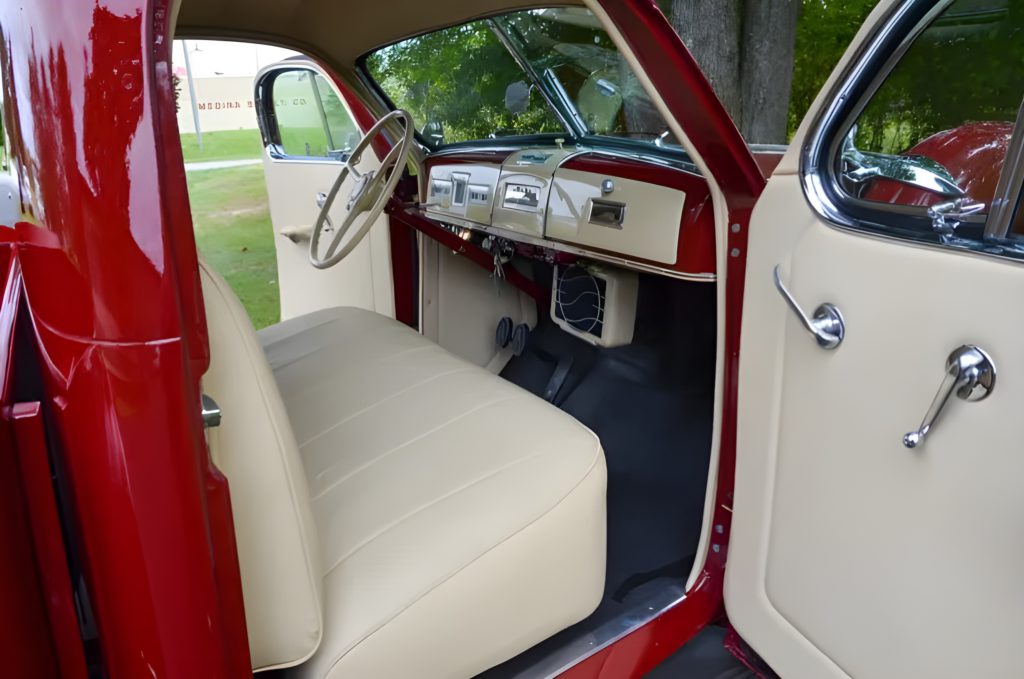
Optional radios and heaters elevated comfort beyond typical work vehicles inside the L5 Coupe Express. The standard six-cylinder engine provided adequate performance, complemented by an available overdrive transmission improving highway efficiency. Dashboard layout borrowed heavily from Studebaker’s passenger cars, giving drivers more refined surroundings than most commercial vehicles offered. This blend of comfort and utility arrived before the market fully embraced the concept, making the L5 Coupe Express a visionary vehicle that suffered from timing rather than conceptual limitations.
14. Chevy Big 10 Truck (1975-1980)
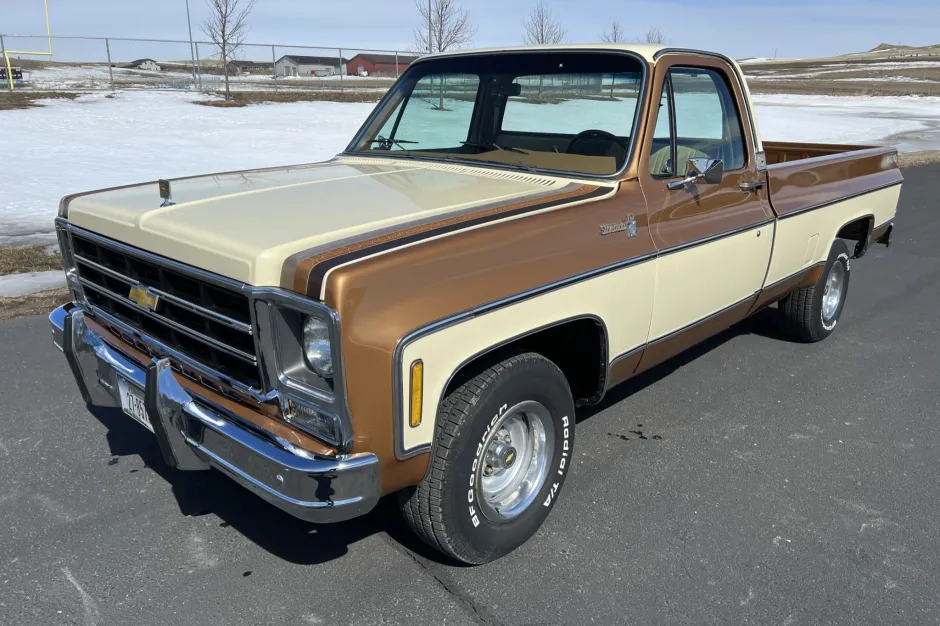
Heavy-duty capability in a half-ton package defines the Chevy Big 10 (1975-1980). This 2WD workhorse included the F44 heavy-duty spring package for exceptional payload capacity. The optional 454 V8 engine transformed this utilitarian pickup into a genuine performer, while weight classification exempted it from catalytic converters required on lighter vehicles. Distinctive Big 10 badging signaled its upgraded capabilities to knowledgeable truck buyers. Shortbed Big Block configurations now command premium prices when they occasionally surface in the collector market.
Chevy Big 10 Truck (Interior)

Balancing utility with comfort, the Big 10’s cabin featured thoughtfully designed controls and instrumentation. Power brakes came standard, ensuring confident stopping despite increased payload capacity. The 305 V8 delivered adequate performance for daily use, while serious haulers opted for larger displacement options. Bench seating accommodated three adults with reasonable comfort for the era. Dashboard layout prioritized visibility and accessibility, maintaining Chevrolet’s reputation for driver-friendly ergonomics.
13. Ford Unibody Pickup Truck (1961-1963)

Tradition gave way to innovation in the Ford Unibody Pickup (1961-1963) by integrating cab and bed into a single-piece design. This approach created a sleeker profile while increasing cargo space by eliminating redundant structural elements. The continuous body line running uninterrupted from cab to tailgate distinguished these trucks from conventional pickups. Cost savings motivated this design, but structural weaknesses appeared when hauling heavy loads, leading to its brief production run and current rarity among collectors.
Ford Unibody Pickup (Interior)
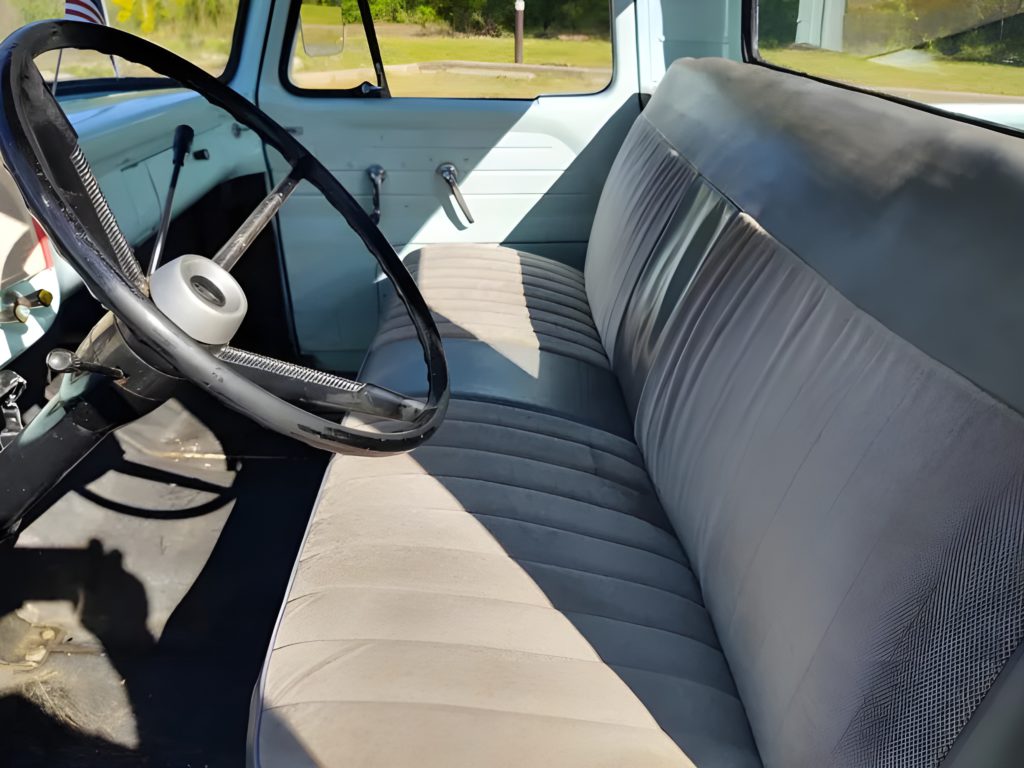
Working professionals influenced the Unibody’s cabin design with essential functionality without unnecessary frills. Engine options included reliable inline-sixes and V8s to meet various work requirements. Clear instrumentation avoided distracting complexity, while intuitive control layouts enhanced usability. The bench seat provided adequate comfort for daily driving tasks. Farmers and small business owners appreciated the practical approach to interior design. Brief production means finding examples with well-preserved interiors requires significant effort.
12. Hudson Terraplane Pickup (1937)
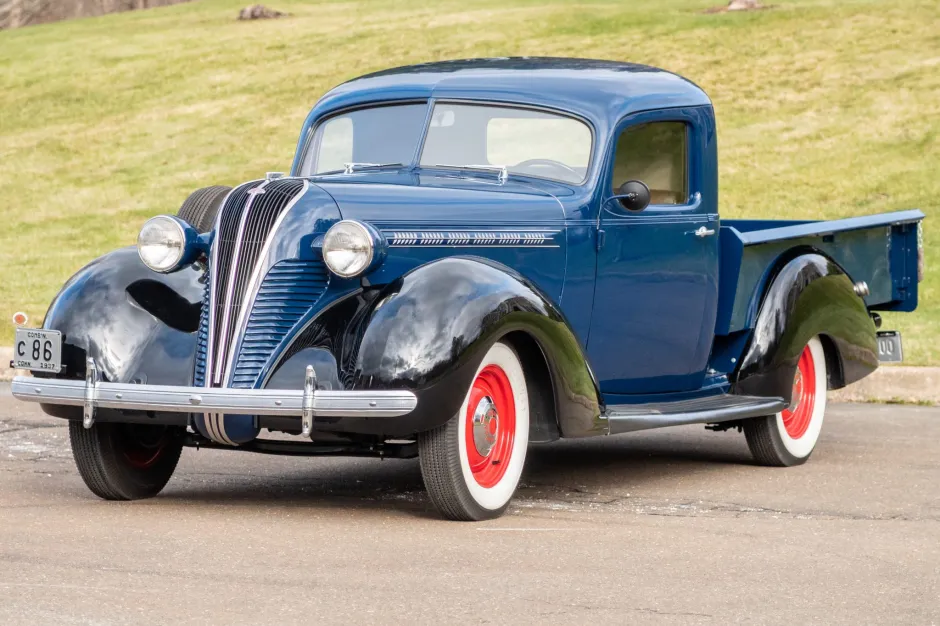
Light commercial vehicles gained refinement with the 1937 Hudson Terraplane Pickup. Hudson Motorcar Company crafted these trucks with streamlined bodywork featuring Art Deco grille elements. Monobilt construction provided structural integrity without excessive weight. Sleek design combined with robust build quality positioned the Terraplane as a premium offering in the light-duty segment. Few examples survive today, making each authenticated Terraplane pickup a significant historical artifact from Hudson’s commercial program.
Hudson Terraplane Pickup (Interior)
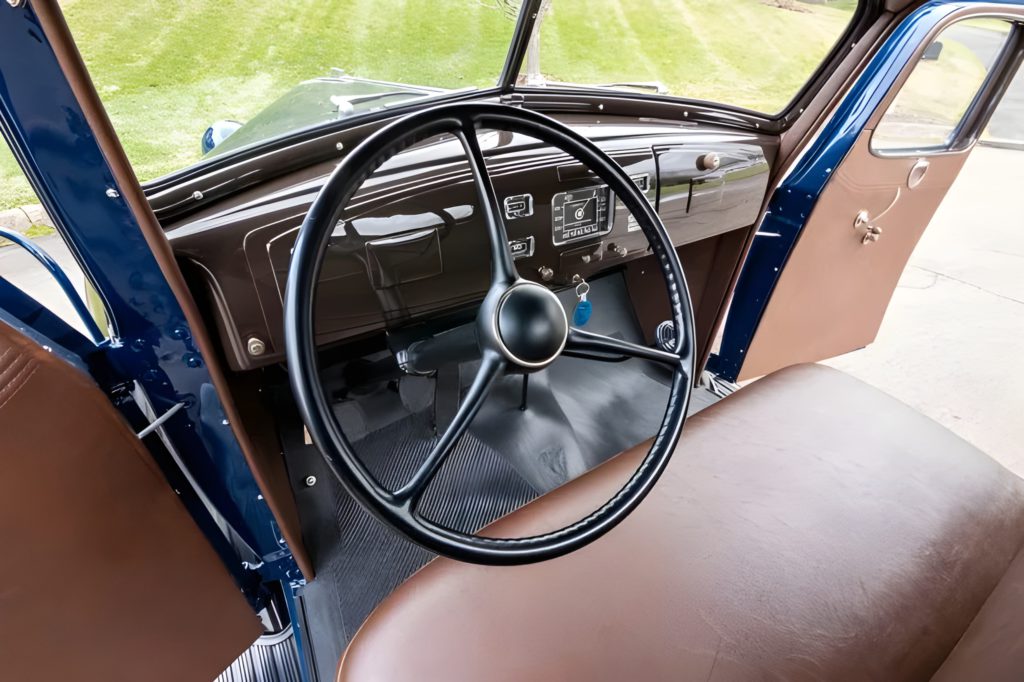
Hudson’s minimalist approach prioritized functionality while maintaining quality reputation inside the Terraplane. The 3.5L flathead engine delivered adequate power while maintaining reasonable operating costs. Durable materials suited work environments without sacrificing comfort. Clearly visible gauges provided essential information at a glance. Driver-focused control layout placed everything within easy reach. This balance of utility and quality distinguished the Terraplane from mass-market competitors of the era.
11. International L120 Pickup Truck (1952)
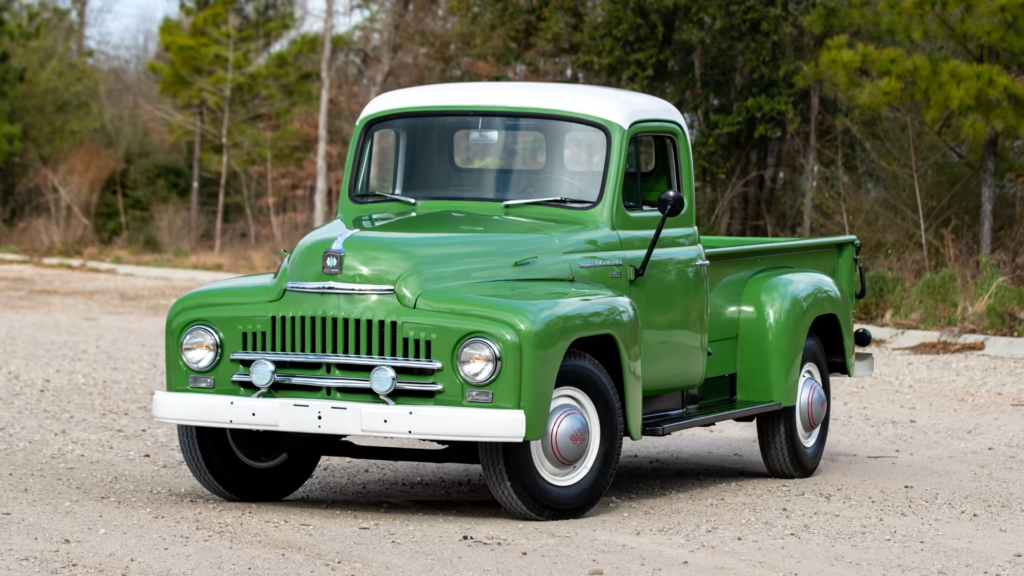
Building on commercial vehicle expertise, the 1952 International L120 improved significantly over the earlier L110 platform. Hercules design work contributed distinctive styling cues that aged well. Two-piece rear windows offered ventilation options while creating a unique aesthetic element absent from competing trucks. Australian markets received this model as the AL series, establishing a global reputation for durability. Design quirks that limited mass appeal now make the L120 desirable among collectors seeking alternatives to common domestic offerings.
International L120 Pickup (Interior)
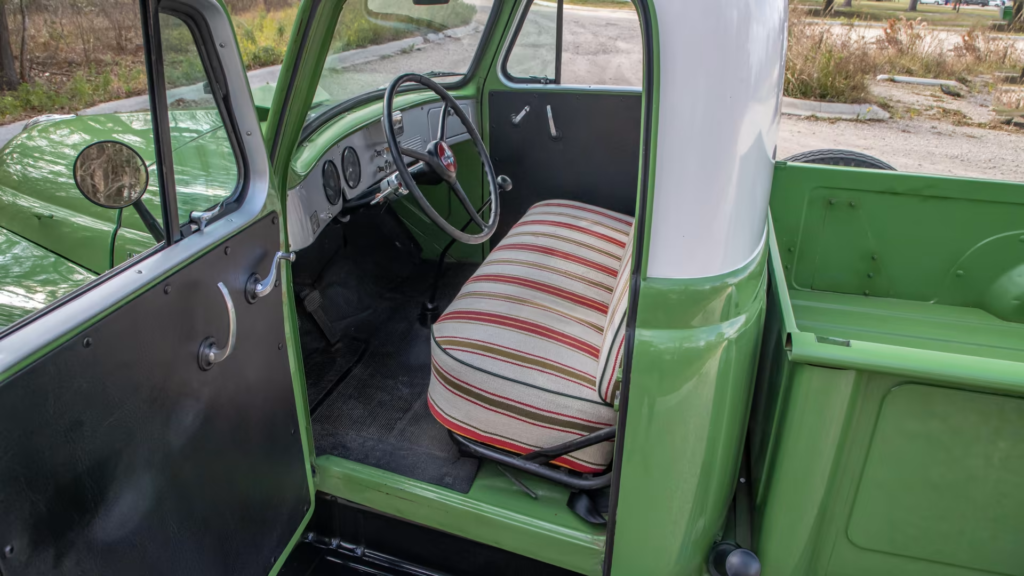
Spacious cab dimensions separated the L120 from competitors, offering comfort unusual for commercial vehicles of that era. The 220 cubic inch straight-six balanced performance with efficiency. International Harvester’s experience showed in logical control layouts and durable components withstanding years of daily use. Straightforward instrumentation provided essential information without complexity. These practical attributes made the L120 popular with businesses requiring dependable transportation in challenging environments.
10. Nissan Hardbody Desert Runner (1988)
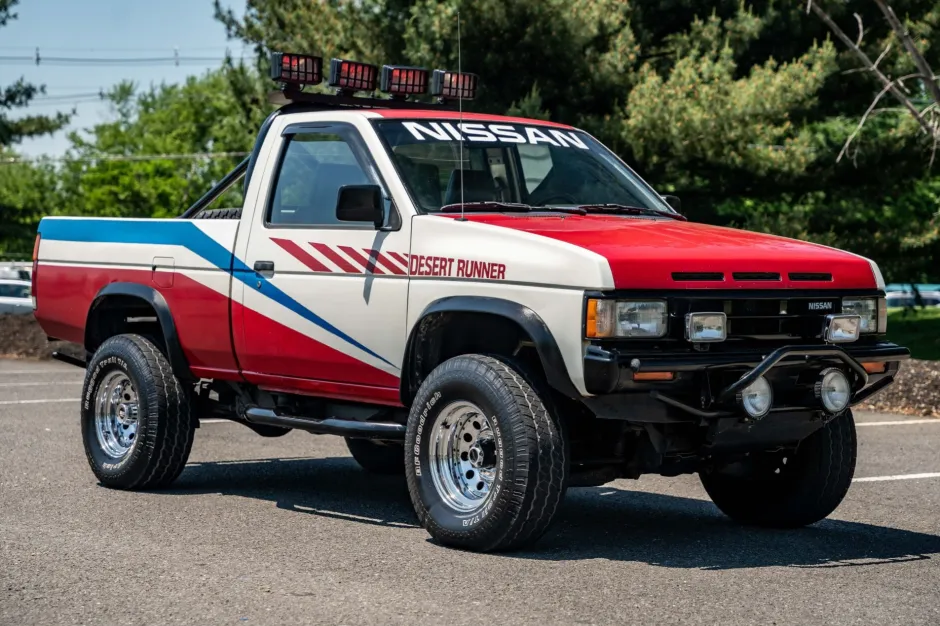
Off-road racing success inspired the 1988 Nissan Hardbody Desert Runner with purpose-built capability. Oversized tires provided exceptional ground clearance alongside functional tubular bumpers and bull bar protection. A bed-mounted roll cage combined safety with distinctive styling. This configuration demonstrated Nissan’s commitment to authentic off-road performance rather than cosmetic packages. Competition-inspired design elements reflected real-world testing in harsh conditions, making survivors highly sought by collectors and enthusiasts.
Nissan Hardbody Desert Runner (Interior)
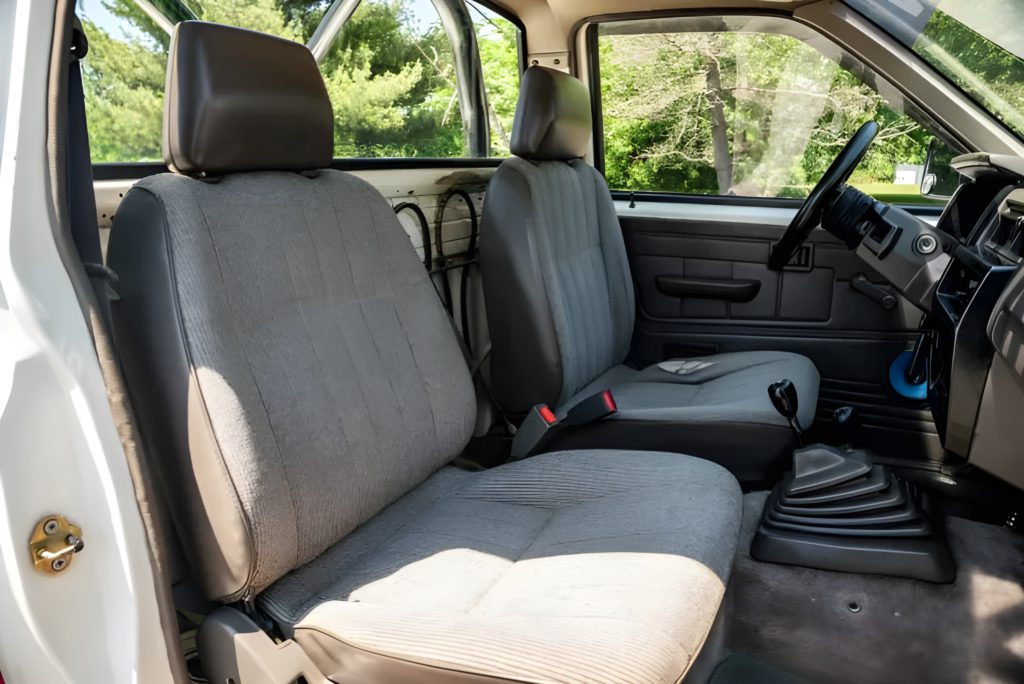
Supportive seating and logical controls balanced function with comfort in the Desert Runner’s cabin. The 3.0L V6 engine delivered power for highway cruising and off-road challenges alike. Proper four-wheel drive with low-range gearing enabled confident navigation through difficult terrain. Straightforward instrumentation avoided distracting complexity. Durable materials withstood off-road abuse while maintaining reasonable daily comfort. This dual-purpose capability distinguished the Desert Runner from specialized trucks limited to either pavement or trails.
9. Ford F250 (1968)
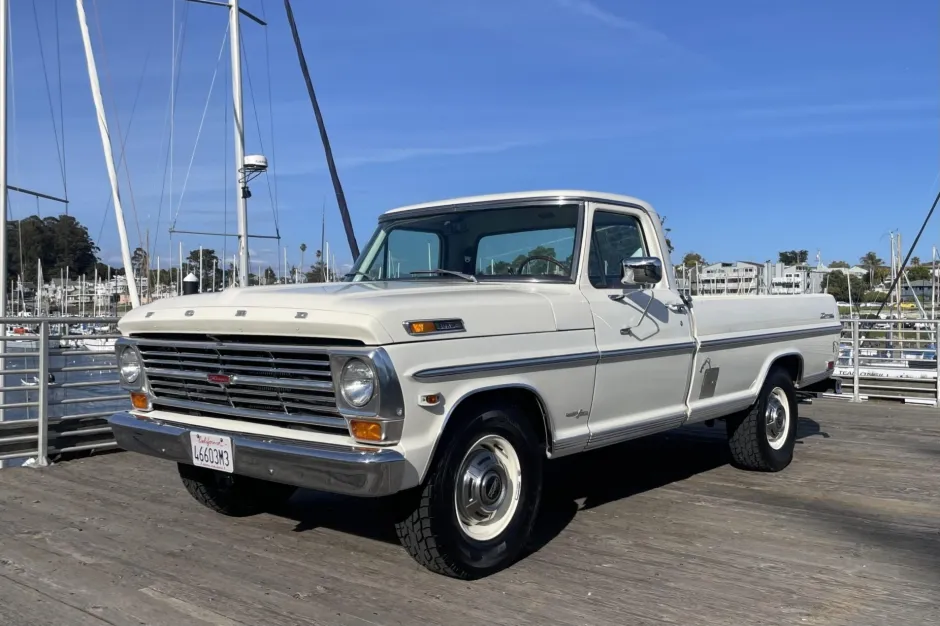
The 1968 Ford F250 established a visual language that defined Ford trucks for decades. This 3/4-ton workhorse featured sharp lines and a boxy profile prioritizing function while creating distinctive presence. Detailed grille design became an instant identifier, setting it apart from competitors. Available in multiple sizes and body styles, the F250 met diverse work requirements. The twin I-beam front suspension improved ride quality without compromising payload capacity, addressing a common complaint about work trucks of the era.
Ford F250 (Interior)
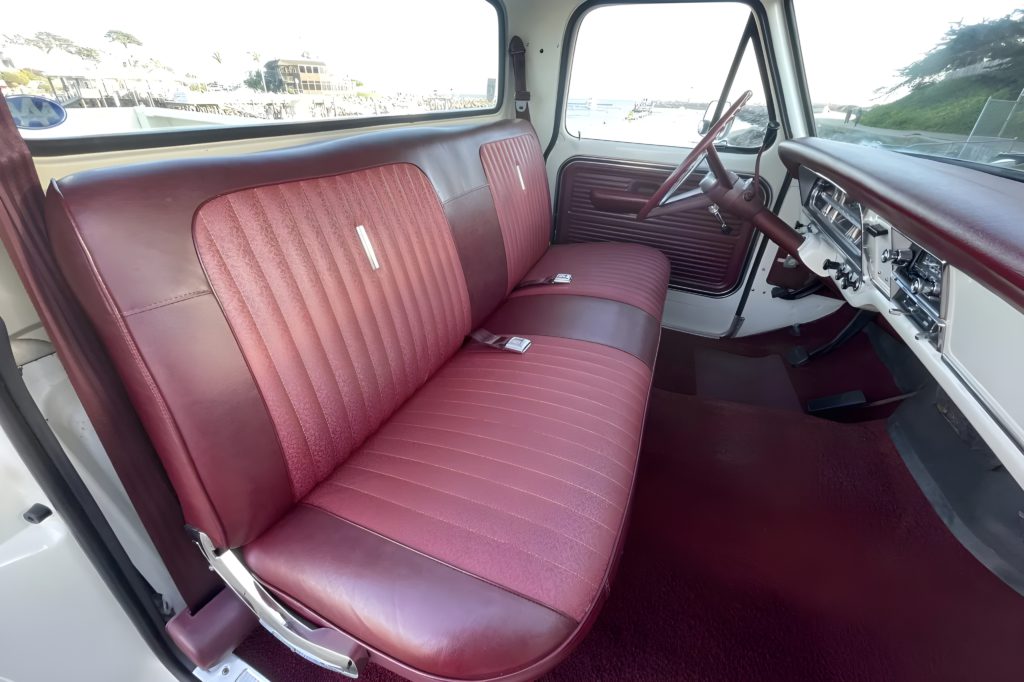
Durability and functionality define the F250’s cabin with straightforward controls positioned for easy operation even with work gloves. New 360 and 390 cubic inch engine options delivered substantial power for towing and hauling. Practical interior layout reflected Ford’s understanding of working professionals’ needs. Clearly visible gauges provided essential information at a glance. Though some early engines experienced reliability issues, the platform’s overall durability established the reputation for longevity that became a cornerstone of F-Series marketing for decades.
8. Tempo Matador (1949-1951)
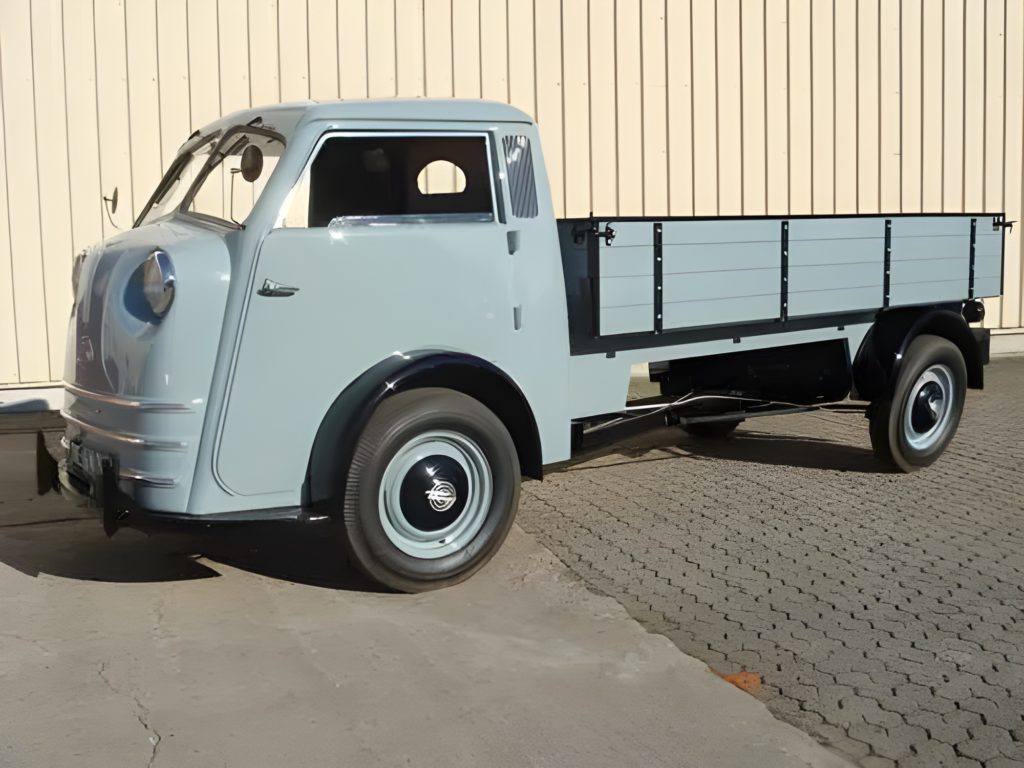
Post-war Germany produced the innovative Tempo Matador (1949-1951) with forward-thinking engineering. Front-wheel drive layout maximized interior space while improving traction with loaded cargo. Functional German design emphasized practicality over styling flourishes. Volkswagen engines initially powered the Matador before supply arrangements ended, limiting production numbers. This unusual configuration and European heritage make it one of the most distinctive pickup trucks ever produced, virtually unknown to most truck enthusiasts.
Tempo Matador (Interior)
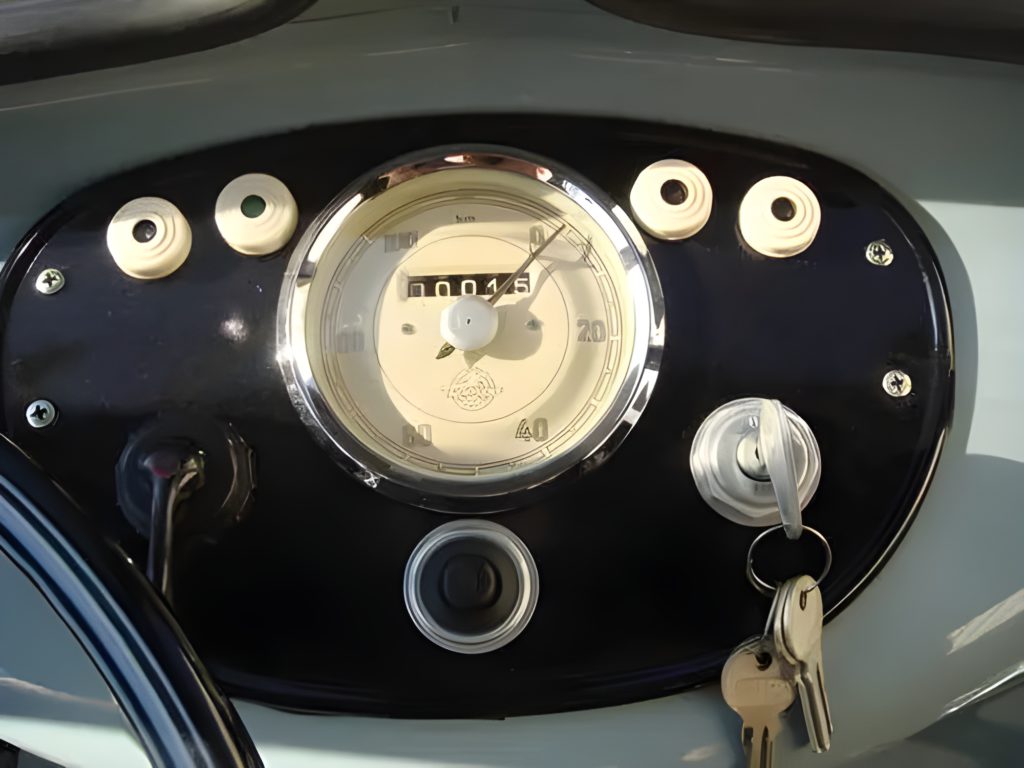
Driver comfort received priority in the Matador through thoughtful ergonomics unusual for commercial vehicles of that era. The Volkswagen engine balanced adequate performance with exceptional fuel efficiency. The ZF gearbox provided precise control compensating for modest power output. German engineering philosophy shaped every interior aspect, eliminating unnecessary components while ensuring essential functions received proper attention. This approach created a uniquely European interpretation of the pickup truck concept, distinct from American designs emphasizing size and power.
7. Ford Skyranger (1991)
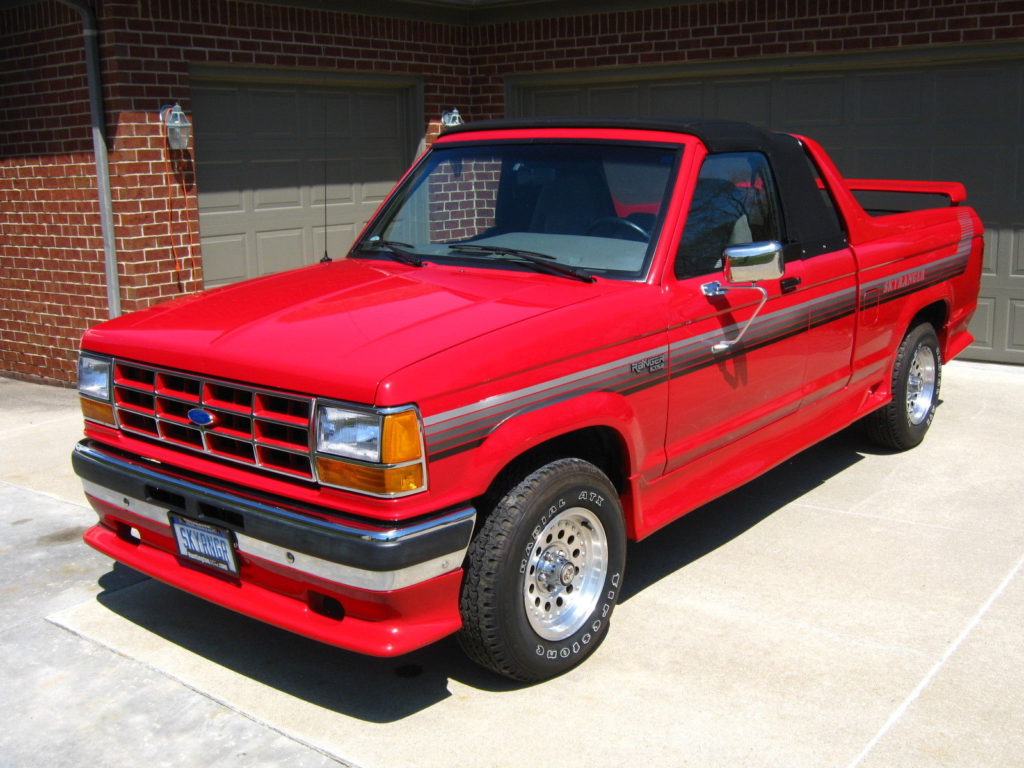
Ford took the unusual step of removing the roof from a compact truck, creating an open-air experience typically reserved for cars. The 4.0L V6 engine delivered strong performance, while four-wheel drive maintained genuine off-road capability despite the unconventional body. Limited production explains why most truck enthusiasts have never seen one. The distinctive profile makes it immediately recognizable to knowledgeable Ford collectors.
Ford Skyranger (Interior)
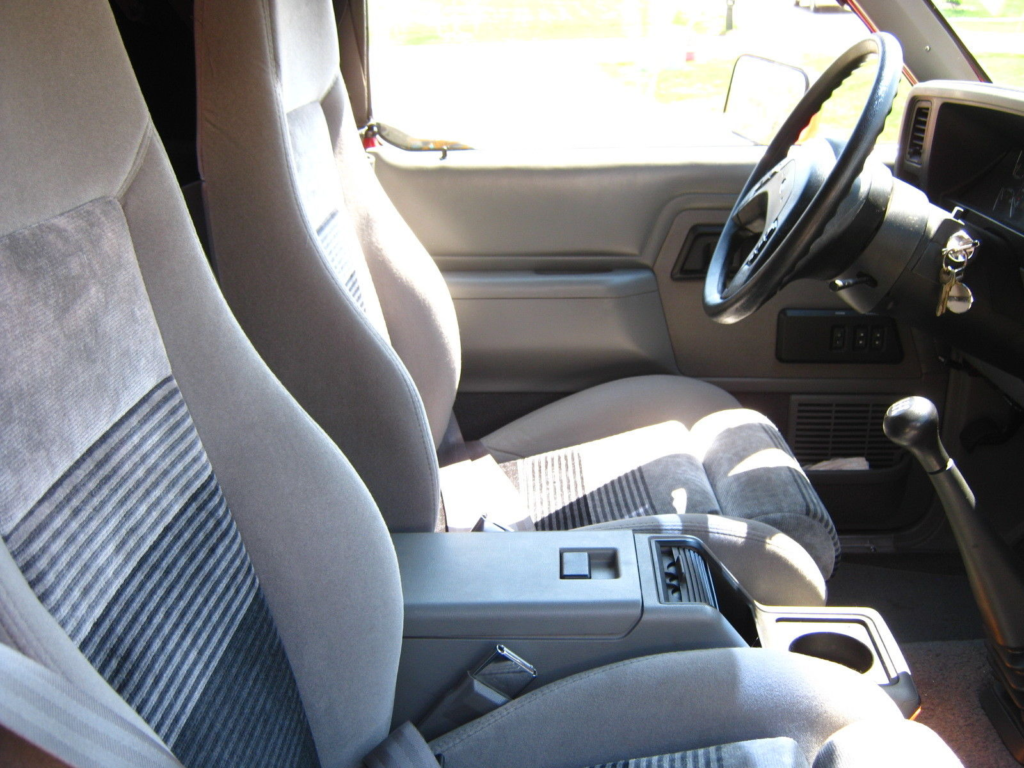
Direct control came via the five-speed manual transmission in the Skyranger, enhancing the engaging driving experience. Extended cab configuration offered additional storage behind the seats, maintaining practicality despite the convertible design. Weather protection remained minimal compared to hardtop trucks, limiting appeal in harsh climates. Standard Ford Ranger instrumentation carried over unchanged, focusing driver attention on the road. This combination of familiar controls with exotic body configuration appeals especially to collectors seeking unique Ford trucks.
6. International Harvester K-Series Pickup (1940s)
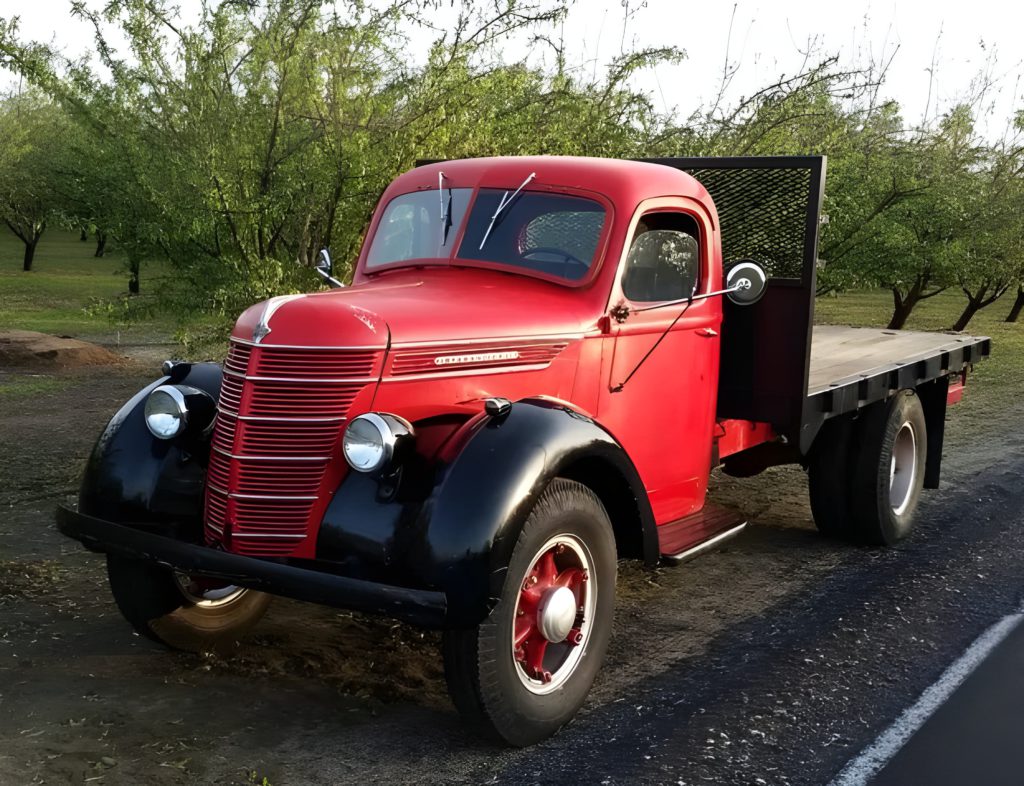
Multiple configurations (K1, K2, and K3 models) met diverse work requirements with increasing capacity. The 1947 KB models introduced stylistic upgrades without compromising functionality. Clean body lines created a distinctive identity without unnecessary decoration. Economic factors limited mainstream success, resulting in scarcity that makes preserved examples valuable to commercial vehicle collectors.
International Harvester K-Series (Interior)
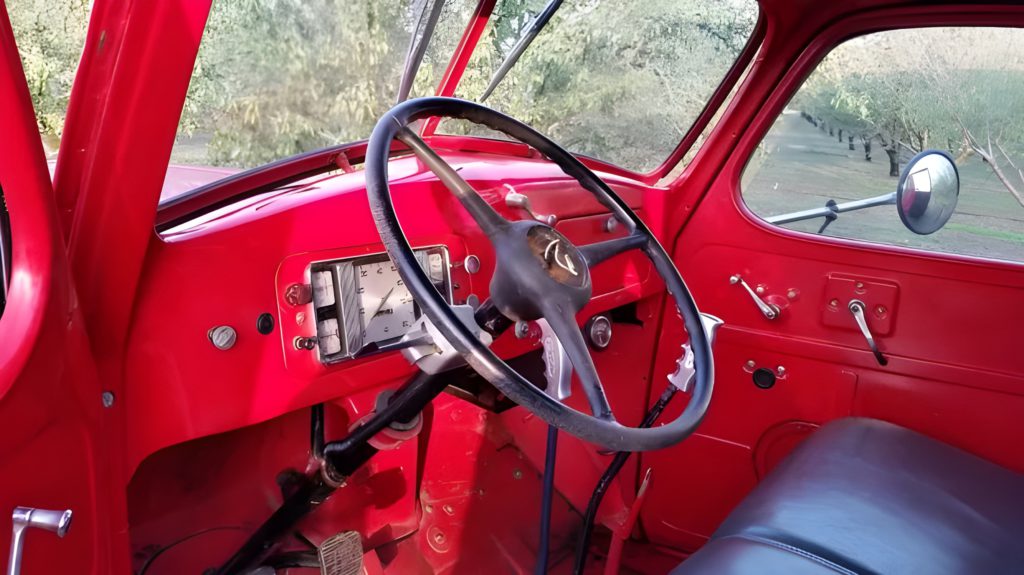
Practical functionality drove K-Series cabin design with intuitive controls positioned for efficient daily work. Clear gauges provided essential information at a glance. Durable materials prioritized longevity over luxury throughout the seating and touch points. Storage remained minimal but sufficient for working environments. Affordable pricing attracted small businesses and farms seeking reliable transportation, establishing International Harvester’s reputation for practical commercial vehicles.
5. Mercedes-Benz 170 Pickup Truck (1952)

Post-war reconstruction birthed one of Mercedes-Benz’s most obscure trucks – the 1952 Mercedes-Benz 170 Pickup. This rare utility vehicle featured the reliable 1.7L diesel engine known for exceptional durability. Limited Swiss production guaranteed extreme rarity today, with few surviving examples even in European collections. Unlike typical work trucks, this model maintained Mercedes’ commitment to build quality despite utilitarian purpose, with precise panel gaps and durable construction.
Mercedes-Benz 170 Pickup (Interior)
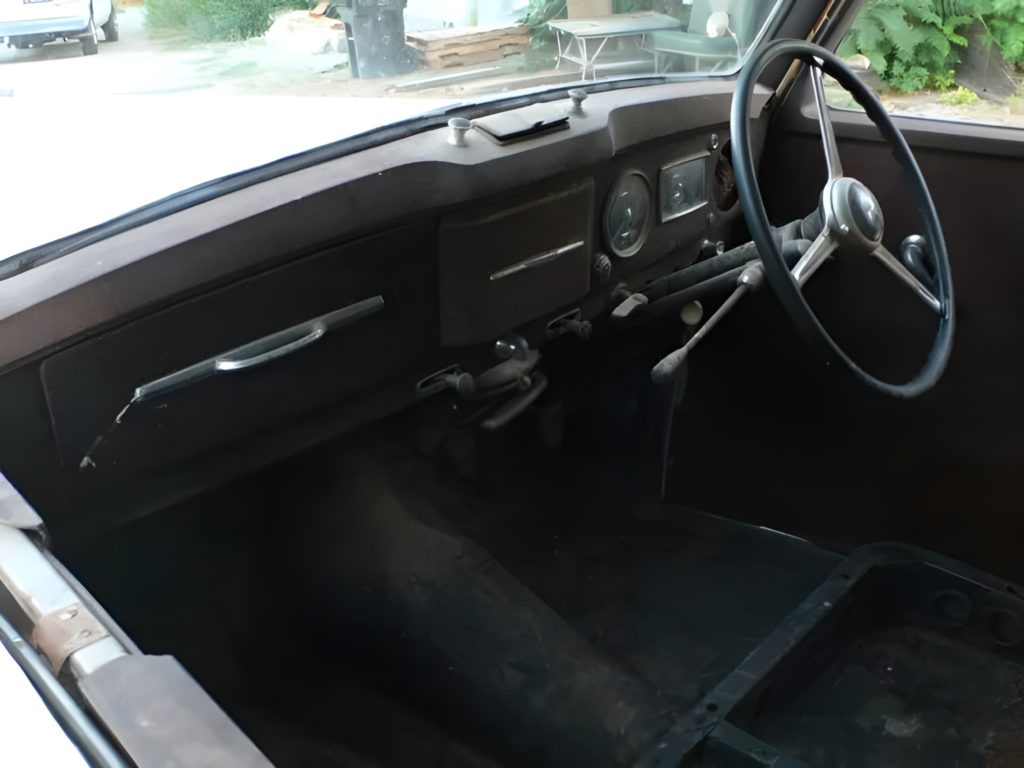
The 170 Pickup’s cabin features logical control placement and durable materials. The four-speed manual transmission provided precise gear selection that maximized the diesel engine’s modest output. Essential gauges displayed with characteristic Mercedes clarity populated the instrument panel. Cab comfort exceeded typical work truck standards while maintaining functional focus. Finding complete original interiors represents an extraordinary challenge for collectors seeking this obscure commercial vehicle.
4. Chevrolet Apache Pickup Truck (1955)
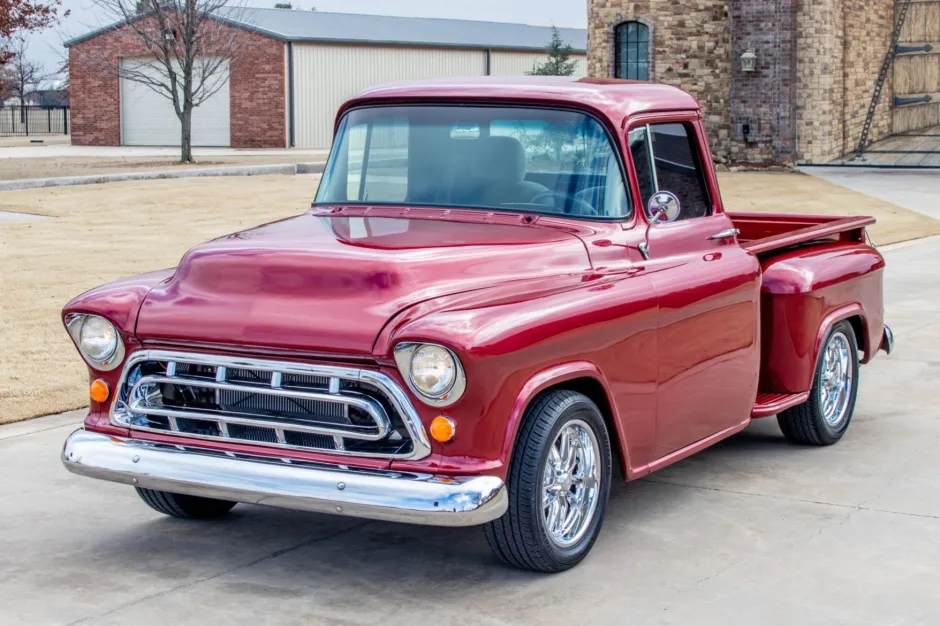
The 1955 Apache introduced Chevrolet’s Task Force series with transformative styling. A wraparound windshield improved visibility while creating a distinctive profile. The optional V8 engine brought car-like performance to trucks, establishing a precedent that continues today. Balanced proportions worked equally well with standard and optional 7-foot bed configurations. Various trim levels offered customization unusual for work trucks of that era, reflecting Chevrolet’s understanding of the truck market’s evolution beyond commercial applications.
Chevrolet Apache Pickup (Interior)
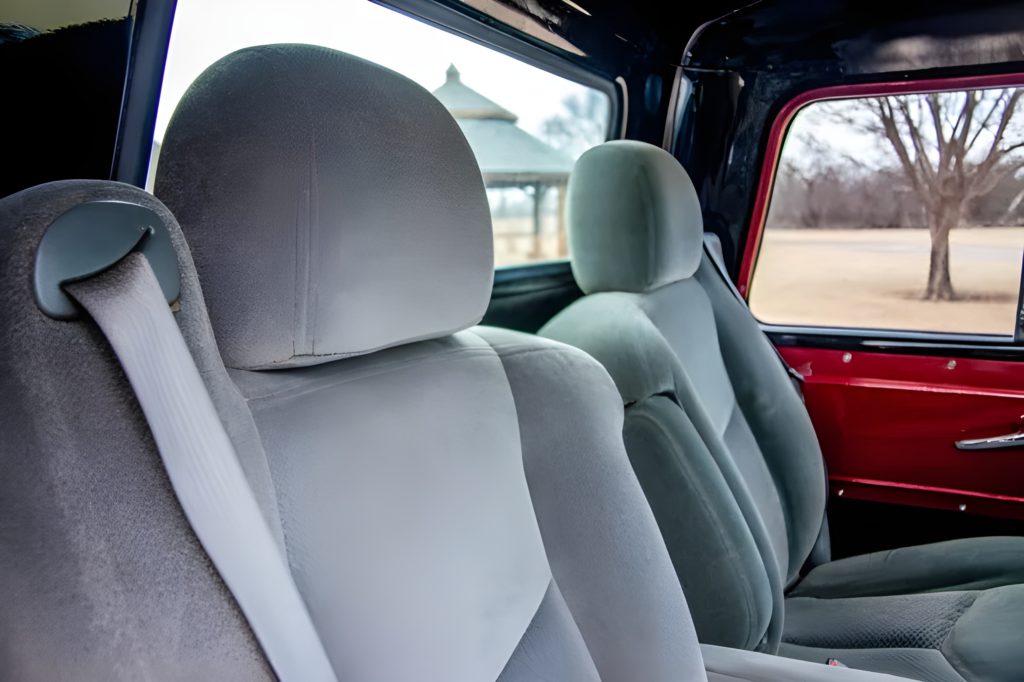
Logical control placement improved ergonomics over previous models. Clear gauges positioned within the driver’s line of sight provided essential information at a glance. Seating comfort improved notably, acknowledging that owners spent significant time behind the wheel. V8 power transformed the driving experience with smooth delivery unexpected in period trucks, helping establish the pattern for modern pickups blending work capability with personal comfort.
3. GMC Sonoma GT (1992)
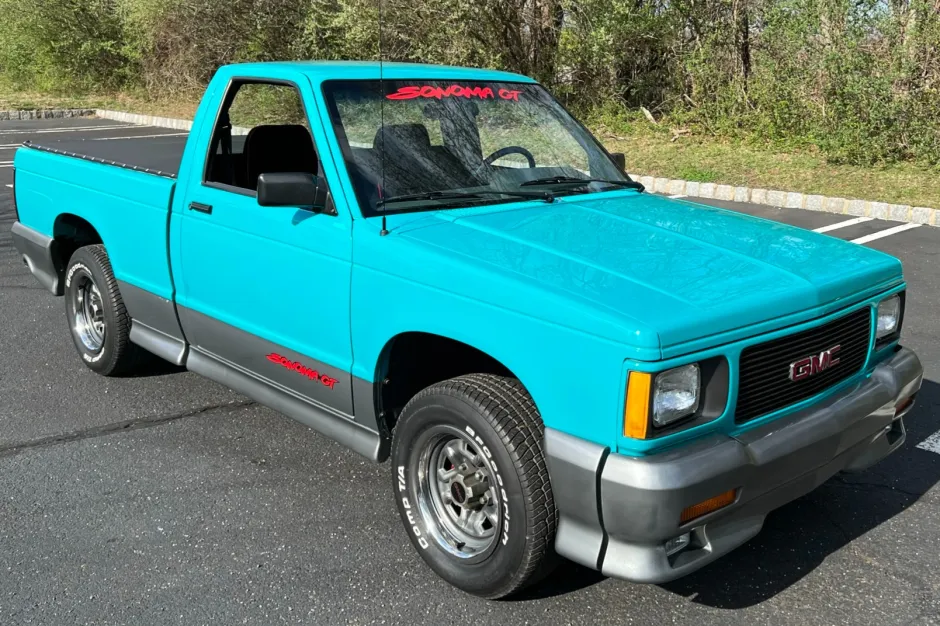
Performance DNA from GMC’s Cyclone muscle truck lives in the 1992 Sonoma GT. A distinctive body kit transformed this compact pickup into a street performance machine with presence. The 4.3L V6 engine delivered impressive acceleration, while Bilstein shocks significantly improved handling dynamics. Limited production created genuine scarcity in today’s market. The Sonoma GT’s focused performance approach contrasted sharply with the off-road emphasis of most trucks from this period.
GMC Sonoma GT (Interior)
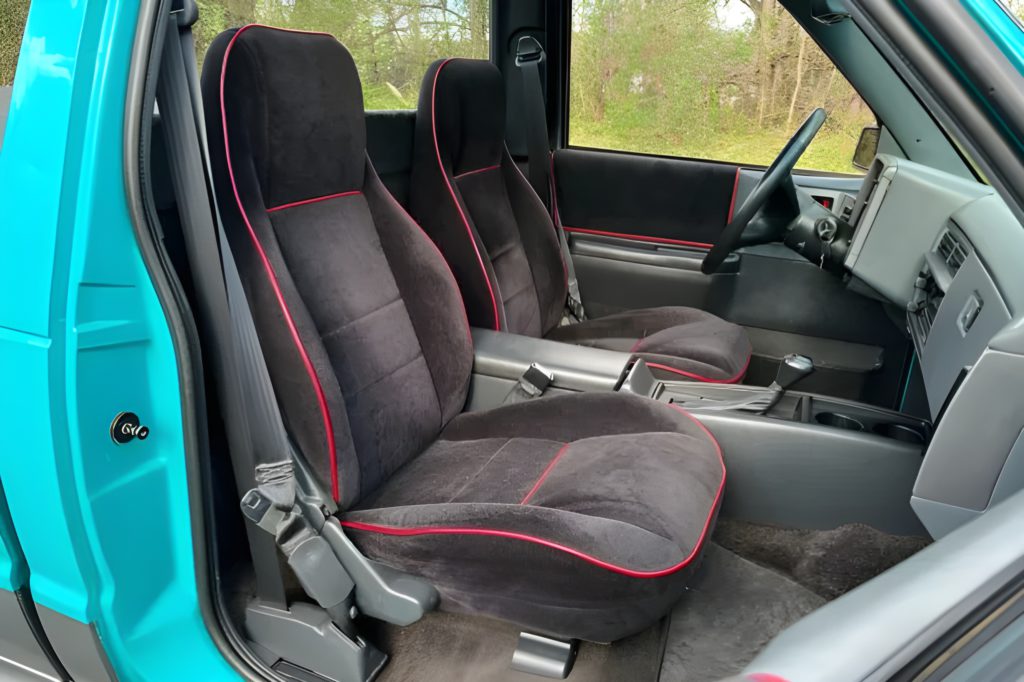
Sporty touches complemented the exterior’s performance theme throughout the Sonoma GT’s cabin. Standard automatic transmission simplified daily driving while maintaining strong acceleration. Upgraded bucket seats provided improved lateral support during spirited driving. Clear gauges displayed essential information in GMC’s straightforward approach. Controls fell readily to hand, preserving functionality despite performance orientation. This package transformed the workaday Sonoma into a specialized street machine without sacrificing the practicality that made compact trucks appealing.
2. Ford Ranchero GT (1971)
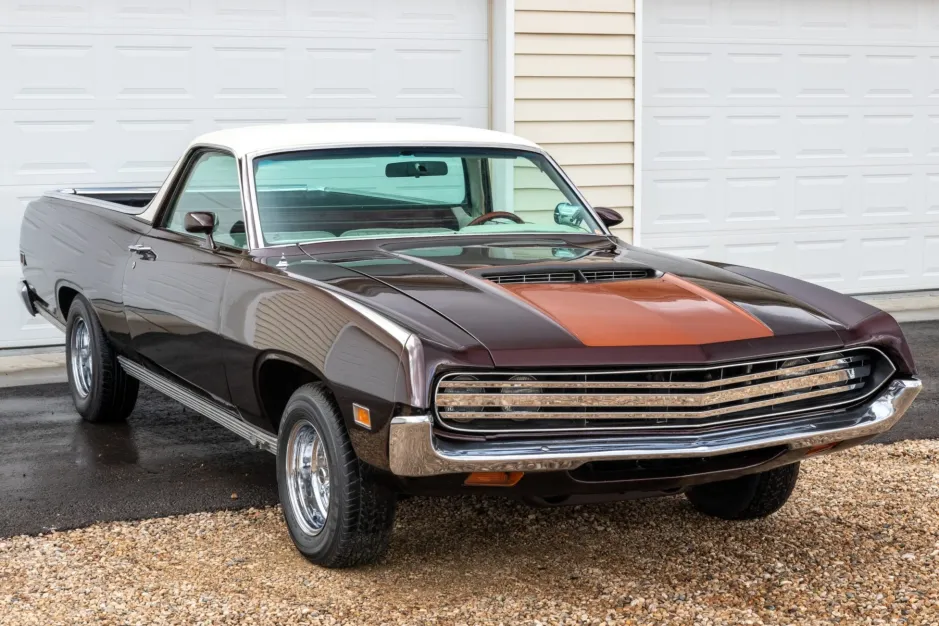
Australian “ute” concept evolved into a genuine muscle truck with the 1971 Ford Ranchero GT. Multiple trim packages allowed buyer personalization, while the Ram Air hood added style and functional cooling. The optional 429 Cobra Jet engine transformed the Ranchero into one of Ford’s quickest vehicles, delivering muscle car performance with pickup utility. Factory air conditioning made the GT practical for daily use despite its performance focus. Lower sales figures compared to pure muscle cars have created significant scarcity in today’s collector market.
Ford Ranchero GT (Interior)
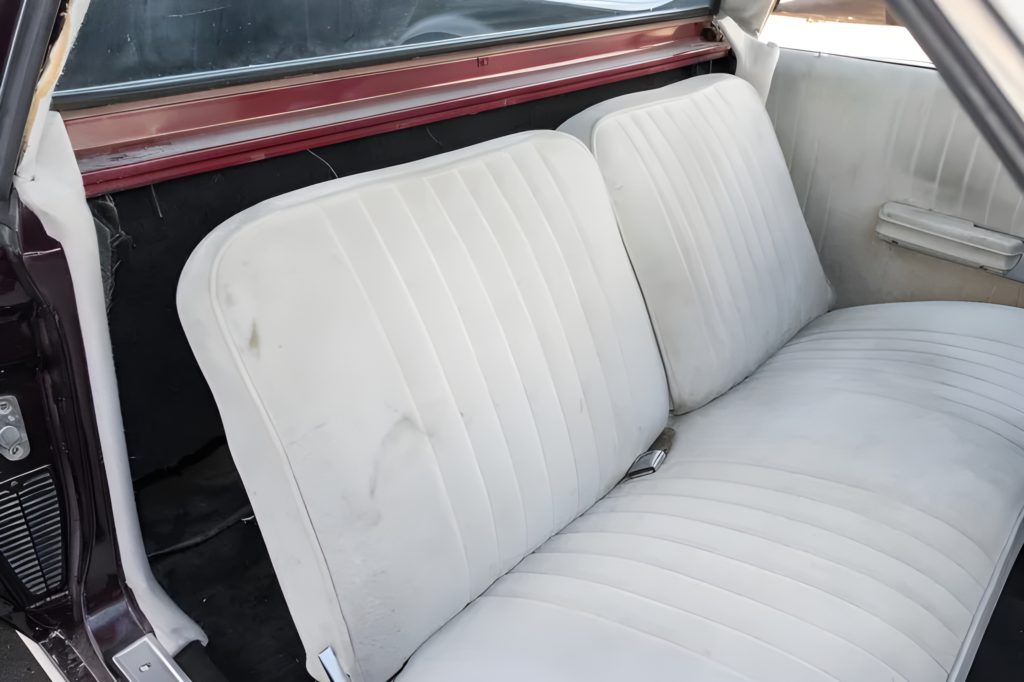
Passenger car DNA influenced the Ranchero GT’s cabin, creating a driver environment more sophisticated than typical trucks. Various trim levels offered different appointments, letting buyers prioritize luxury or performance. Engine options ranged from six-cylinder efficiency to the Cobra Jet V8 that delivered acceleration rivaling dedicated sports cars. Clear gauges monitored vital engine functions through a driver-focused dashboard layout. This blend of performance with utility makes the Ranchero GT appealing to collectors seeking something beyond conventional muscle cars. As cool as the Ranchero is, it doesn’t compare to the rides in Will Smith’s car collection.
1. Willys Jeep Pickup (1958)
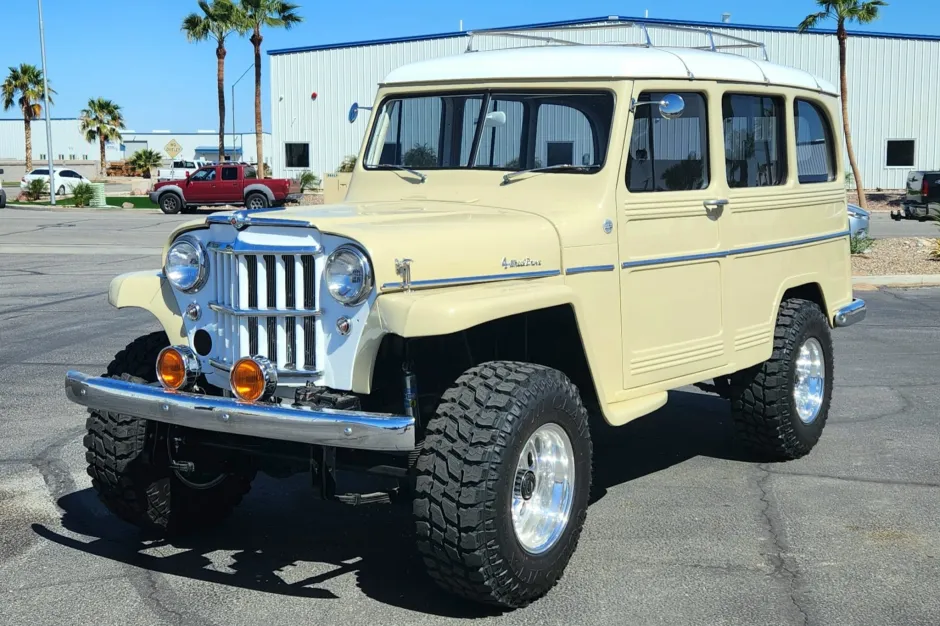
Rugged simplicity defines the 1958 Willys Jeep Pickup, also known as the Super Hurricane. Utilitarian design prioritized capability over styling with functional elements throughout. The L6 226 engine provided reliable power for demanding environments without complex electronics or emissions controls. An optional Maverick package added specialized work equipment for specific applications. Unassuming appearance kept this model out of the spotlight compared to heavily marketed competitors, contributing to its relative obscurity despite reasonable production numbers.
Willys Jeep Pickup (Interior)
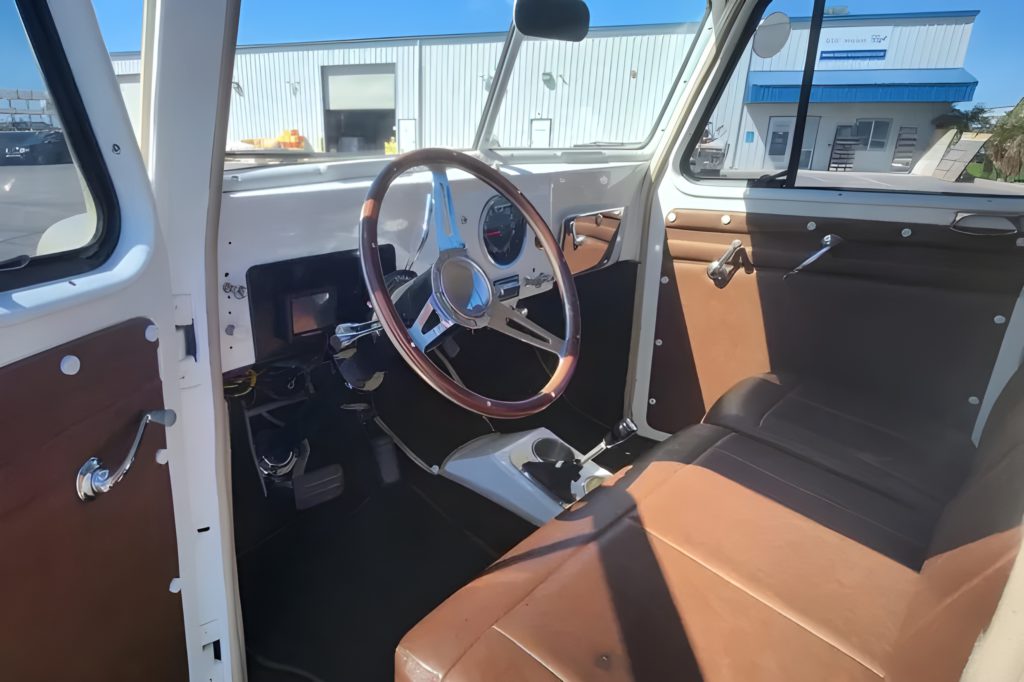
Simplicity rules the Willys pickup cabin with straightforward controls positioned for intuitive operation in challenging conditions. Weather-resistant materials throughout emphasized durability over luxury. Essential gauges provided critical information without unnecessary complexity that might compromise reliability. Clear visibility from the driving position facilitated off-road navigation and work site maneuverability. This focused approach created a purpose-built tool rather than attempting to balance utility with creature comforts.





















